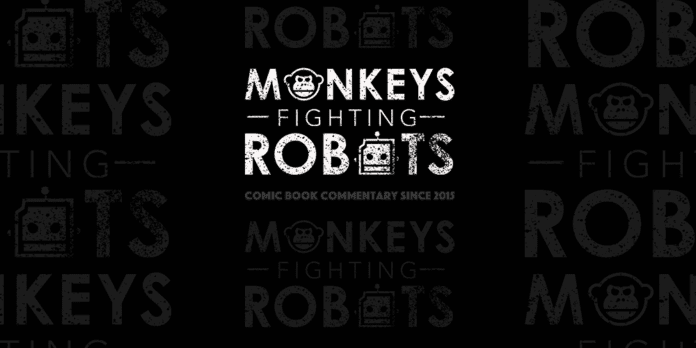Double Dare is back but is it a welcomed return? Nostalgia is a tricky thing to talk about. Everyone’s childhood is different, and as a result, it can be hard to rationalize your feelings on something. As an adult, it may not be as good as you remember. I’ve always found the way to counteract nostalgia is to keep everything objective. To this end, I’ll review this show as it were any other show.
Why am I saying all this? Well, just recently Nickelodeon premiered its much-hyped revival of Double Dare, and you better believe I have a strong feeling about it.
I never saw the original when it first aired. However, I was able to catch reruns on the departed Nick GAS network, when I was growing up. So, I did grow up on the series, just not in the way you’d expect (this explains why whenever I see someone going as a team from Legends of the Hidden Temple, I smile to myself).

So why did I bring up nostalgia in the opening paragraph? Well, whenever I see people praise this new revival, I wonder if the reviewers were paid off. They seemed so blinded by so much nostalgia; they were already hailing the revival before it came out. As a result, I’ll be gentle, where I can. After watching five or six episodes, I was ready for proverbial blood. A final note, at specific points I’ll compare the original and the revival. Is this fair to do? Not really, however, if Nickelodeon spent the money to build a modern replica of the set, hired the original host, and brought back the composer to remix the themes, then it’s not a question of fairness anymore. It’s more of a foregone conclusion.
The Positives
The set design is downright impressive, updating the original design, and even keeping the eggcrate numbers (although they’re now digital). I also love how both the main set and the obstacle course are organized in the studio. Marc Summers is a delight, and it always makes me happy to see him on TV. Even Edd Kalehoff was brought back in to revise his original music, and the music’s still as catchy as ever. The obstacle course keeps a lot of the classic charm, with the giant pool, the giant nose, and the sundae slide, all making return appearances.

Minor Problems
First, technical quibbles, these are minor, but minor problems add up, and next thing you know you’re being chased by a giant snowball. Notably, the sound effects are the not the originals. This seems minor, yet when they put all the effort in doing a semi-recreation of the original show, for Nick not to use the original sound effects is sacrilege. Why is the end of round sound effect now (what Desus & Mero called) a “Wild dance horn?” For all I know when I hear the sound effect, I’m thinking Nagisa (or “Thugisa”) from 50% Off is near. I shouldn’t be thinking this while watching a game show! Also, the “challenge cleared” sound effect is different and nowhere near memorable as the original. There also wasn’t a sound effect for a correct answer and money entering the team’s bank in the original which gets to be grating in the revival.
The second major technical quibble: Why is there a giant vertical screen behind the host podium? The video wall is entirely superfluous, only telling us when a team dares, and the 30-second clock for physical challenges. There’s no reason they could have gone with the digital time clock descending from the roof, and a solid wall, instead of a monitor. From a presentation standpoint, it’s distracting with the vertical monitor going through its animation behind the host.

Second minor problem is the physical challenges and the obstacle course. Some of the new physical challenges introduced lean too much on toilet humor. I’m not saying the original didn’t have these challenges because some of them did. Most of the challenges involved wrapping people up in life-size burrito wraps, throwing pizzas into boxes from long distances, and hitting targets. You know real challenges requiring a certain amount of thought, creative vision, and effort put into them. Double Dare (2018) seems to lack these qualities.


In the obstacle course, the producers added something foolish: The Mount St. Double Dare. This incline rope climb with “top” spewing smoke and presented as a “final” (i.e., permanent) obstacle. The idea of a “final/permanent” obstacle is not a bad one. Yet the only time I saw it in action, it didn’t look appealing. Am I saying a “final” obstacle should be the Aggro Crag from Guts? No, (although that would be awesome) it’s just for a final obstacle, it’s quite lame. Here’s a thought: a final co-op obstacle, where the two team members must work as one to grab the flag, I can’t tell you what it would look like; it’s just a thought.

A Missing Corollary
The previous paragraphs explained a painfully obvious flaw in this revival, yet it’s led me to a theory Nathan Rabin posited when he was on The A.V. Club and writing My Year of Flops. In the entry about Ishtar, he talked about “the Curse of Bigness.” The danger of throwing too much money and production design into projects, traditionally made on the cheap; i.e., comedies. While I found Rabin’s theory to be correct, I felt he was missing a corollary effect and didn’t apply it to television. This is my little contribution.
To explain this, let’s talk about another 80s icon: David Letterman. I always found Letterman to be at his funniest when he under a limited budget. This explains why I feel Late Night with David Letterman holds up better than Late Show. Creativity increases as the budget decreases. The inverse holds true as well.

You can apply this theory to Double Dare. Watch an episode when the show was in Philadelphia (from 1986-through part of 1989), and the innovation is on full display. Physical challenges involving paper airplanes, balancing cans on stomachs, and impromptu theme days like Miami Vice day, or 3-D day (without any 3-D) are all present. These are all creative (and brilliant) ideas coming about with a limited budget and time.
When the show moved to Orlando (from 1989 to 1993, 2000) a lot of the impromptu creativity was lost. Those psychical challenges went from paper airplanes and ping-pong balls to over-sized props which seemed convoluted and impossible to recreate at home (unless your dad was a special effects builder). Was the show still good? Obviously, yes! However, some of the charm was lost, and you would be surprised how much you can miss charm, if it’s not there. Double Dare (2018) [now filmed at the CBS Studio Center in L.A.] has made things larger, and significantly worse.
The Host
Finally, there is the host: Liza Koshy. She is atrocious. I am not joking; she embodies some of the worst traits of lousy game show hosts. She tries too hard to be funny, wants to join in on the action, mugs for the camera, and appears she wants the show to be about her.
Allow me to explain to you what I feel a great game show host should be: a great host is in effect a straight-man. The host sets up the contestants, is seemingly interested in the contestants and the game itself and runs a tight ship (or appears to anyway). While it is possible for a host to be funny, I find the only type of comedy that seems to work (from years of watching game shows) for hosting is sarcasm/snide remarks. Why? It all goes back to the straight man theory. They set everything up, and if they do get a shot at a joke, they make it as snide and sarcastic as possible. There’s a reason straight-men burn cooler than anyone else in comedy. They set up other people to be funny.
Where am I going with this? Simple. A great host can make a good show great; a bad host can make a great show atrocious. Guess which one Koshy is.
As I had mentioned earlier, let’s get to comparisons. Summers got what I talked about two paragraphs ago, on the original show. He understood the quasi-straight-man routine required for game show host, as he had experiences with the creative side of game shows (fun fact: he wrote for a 1970s revival of Truth or Consequences, and the short-lived Jay Wolpert game show Hit Man). For me, Summers was to Double Dare, what Gene Rayburn was to Match Game; indispensable, and if anyone were to try to fill those shoes, it would be an impossible feat.

By contrast, Koshy doesn’t seem to get it. She’s not getting that no one is here to watch you do your stand up schtick when you’re hosting a game show. What people want you to do when hosting a game show: Focus on the game and try not to force in jokes, stay neutral (she gets involved with the kids/contestants, which corrupts the process of fair play.) If you can get them to laugh, good for you, however you need to find the perfect comedic time to do so. Here, she’s seconds off, and it kills all comedic tension. She gets better at hosting in some episodes, then immediately gets worse in others, so you can add inconsistency to the mix as well.
Part of me is wondering where they found someone who couldn’t host a game show to save their life. I did some research and found out she was a “YouTube celebrity” (My soul died a little writing that), which makes perfect sense, because [the joke here was funny but has been taken out because it could offend the universe. We apologize for this oversight. – The Management.] If the roles were reversed and Koshy was the announcer and Summers was the host, this probably would not be an issue. If you need proof take the episode that aired July 27th, when Koshy was fighting a sore throat, and Summers took over hosting in the second round, and the obstacle course. Summers immediately turned the show around, and the show became instantly watchable.

Final Thoughts
I wanted to like this new remake of a classic. The set looks nice, Summers is excellent, and it’s nice to see some of the original obstacles. Unfortunately, the miscalculations that occurred (an awful host, annoying sound effects, and the large stage) are too great to overcome.
New episodes of Double Dare (2018) air at 8 pm weekdays, on Nickelodeon.








